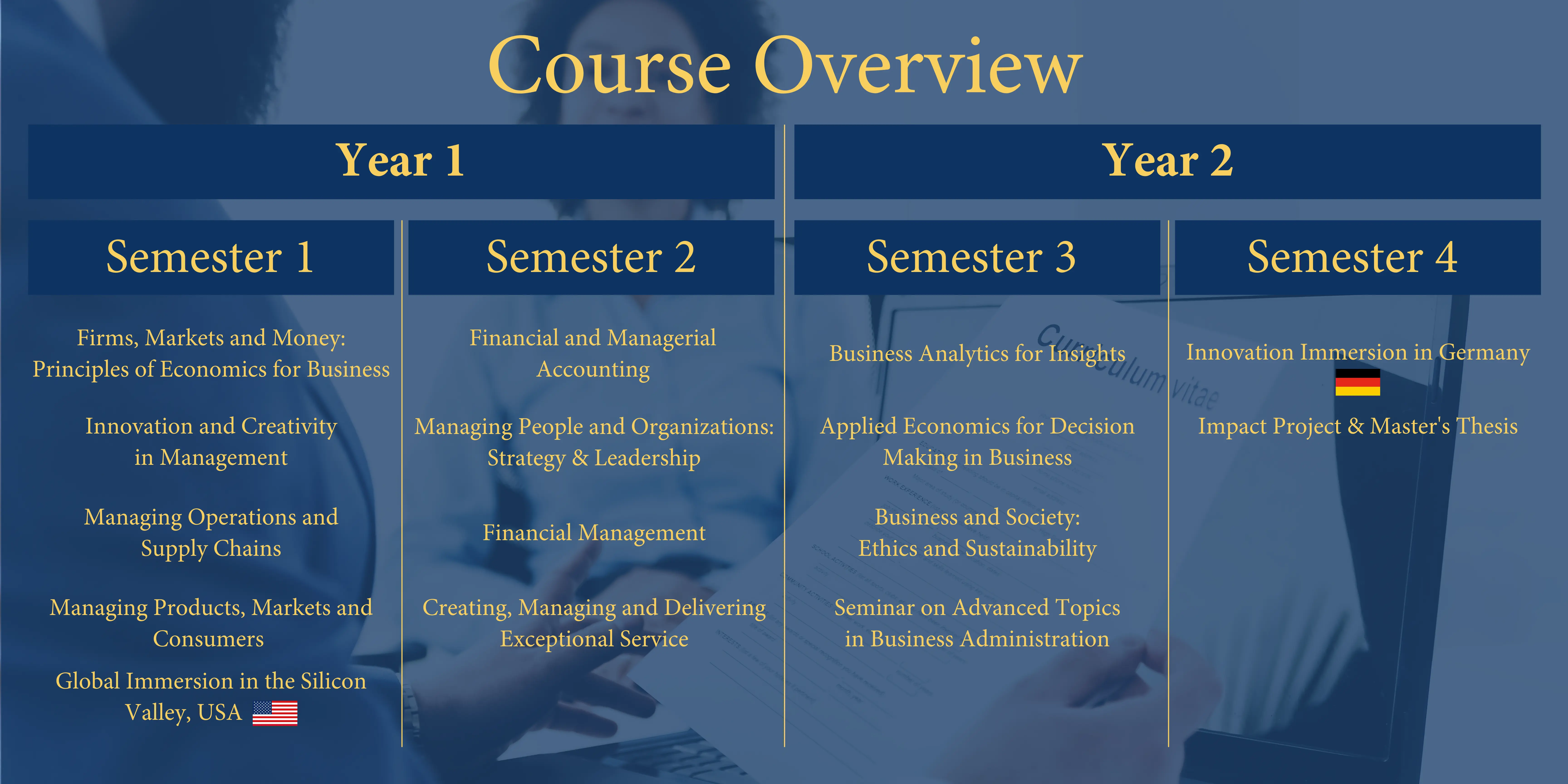Hybrid, Part-Time MBA Program
Degree Structure and Course Modules
More than ever, managers and executives have to develop a broad set of skills and competencies to address complex challenges as the very nature of business evolves rapidly. The aim of the continuing education program, "Master of Business Administration" (MBA), is to provide ambitious working professionals with the mindset and tools to successfully meet complex business challenges and help manage and grow their organizations and enterprises.
Through coursework, global immersions, and out-of-class activities, the program emphasizes “Breadth” and “General Management”, similar to top MBA programs offered in Germany or elsewhere globally. Its objective is to equip students with a holistic understanding of business administration, and it seeks to groom students for top management and leadership positions in the future regardless of their current functional area of expertise.
The activities and coursework of this curriculum, touch on the day to day business challenges.






The program is an independent component of the academic life and offerings of the faculty at the WFI - Ingolstadt School of Management at the Catholic University of Eichstätt-Ingolstadt.
There are 14 teaching modules in this program. Each teaching module comprises 5 ECTS credits and focuses on a specific problem of management. Each module has four days of teaching, including blended learning, whereby it can consist of several sub-topics.
Course Descriptions
Firms, Markets, and Money: Principles of Economics for Business
Learning Outcomes
In this course participants will learn fundamental knowledge in microeconomics and macroeconomics. This course will provide a solid understanding of economic analysis with the goal of developing critical analysis skills in the spheres of micro- and macroeconomics that lasts throughout the student’s education and professional careers. The key learning outcomes include:
- Advanced ability to analyze different types of market structures (monopoly, oligopoly, competitive market) and to understand consumer and firm behavior
- Acutely utilizing the supply and demand diagrams in order to analyze changes in price and quantity
- Demonstrate the ability to utilize economic tools to analyze economic policy
- Critically understand the interactions between the economic theory and practice (financial markets)
- Demonstrate an understanding of macroeconomic models from the short-, medium and long run
- Critically analyze the effectiveness of governmental intervention through fiscal and monetary policies
Besides technical skills in micro- and macroeconomic, students in the MBA program gain skills such as critical and analytical thinking, being able to evaluate signals in markets, professionally visualize changes in graphs and communicate these changes.
Course Content
Part I: Introduction to Microeconomics: Consumer and Producer Theory
- Perfect Competition: Demand and Supply Curves
- Consumer and Producer Surplus
- An Analysis of Political Market Interventions
- Productivity, Costs and Competition
Part II: Market Structures
- Monopoly, Oligopoly and their effects on welfare
- The Policy response: Competition Policy
Part III: Intermediate Microeconomics
- Factor Markets
- International Trade
- Uncertainty, Capital and Supply Markets
Part IV: Introduction to Macroeconomics: The Goods Market & Financial Market
- The GDP and Demand for Goods
- The Demand for Money and Determining the Interest Rate
Part V: The Short-, Medium-, and Long-Run of Technological Progress
- Productivity, Output and Unemployment in the Short-Run
- Technological Progress, Churning and Inequality
Part VI: The Open Economy
- Openness in Goods and Financial Markets
- Output, Interest Rate and Exchange Rate
- Summing up Monetary- and Fiscal Policy
Grading
Take-Home Exam (100%). Students will be required to take a Take-Home Exam. The time provided for the exam will be one week.
Innovation and Creativity in Management
Learning Outcomes
Innovation and Creativity are the key drivers of success for management. Management teams in companies that have experienced substantial gains in shareholder value, particularly over the last decade, have done so based on a culture of creativity and innovation. Innovation and creativity can be successfully managed in organizations to create a sustainable competitive advantage. This course addresses the fundamental question of how to successfully manage and facilitate innovation and creativity in organizations. The primary objectives of this course are to:
- Critically understand why Innovation matters in management, and how it is related to Creativity
- Identify and learn about the various drivers, sources, and types of Innovation
- Develop a framework for managing strategic Innovation in organizations
- Critically examine what Creativity is – research and frameworks on Creativity
- Learn personal and managerial tools and techniques for enhancing individual and team Creativity
- Apply Creativity and design thinking to a real-world business problem on Innovation
Besides technical skills in Innovation and Creativity, working professionals in the MBA program gain skills such as critical thinking and analysis, and professional communication. They will learn how to analyze, discuss and to critically question industry practices in Innovation and Creativity.
Course Content
Part I: Introduction to Innovation and Creativity in Management
- What is Innovation? What is Creativity?
- How are they related in an individual and organization context?
Part II: Drivers and Sources of Innovation
- Organizational factors that enable and fuel Innovation
- How are Strategy and Innovation related?
Part III: Managing Innovation in organizations
- Developing an Innovation Framework for organizations
- Barriers and challenges to Innovation
Part IV: Creativity and Problem Solving
- Frameworks on Creativity
- How to foster individual and team Creativity?
Part V: Creativity and Design Thinking
- Definition and Framework for Design Thinking
- Applying Design Thinking to solve business problems
Part VI: Innovative and Creative Organizations
- Mindset of Innovators and Creators
- Typology of Innovators and Creators
Grading
Presentation (50%) & Take-Home Exam (50%). Students will be required to prepare a presentation and take a Take-Home Exam. The time provided for the exam will be one week.
Managing Operations and Supply Chains
Learning Outcomes
Managing Operations and Supply Chains covers both manufacturing and service industries and explores core concepts and advanced principles and techniques of operations and supply chain management. This course provides a perspective of the various functions that exist within a supply chain, including processes, drivers and performance indicators. Apart from understanding supply chains, successful management requires the ability of situational decision making. Operations Management is devoted to improve decision making under different possible scenarios. This course provides a critical understanding of decision models and how these simplified representations of situations can aid in understanding complex problem formulations. On completion of this course, students are able to:
- demonstrate an advanced understanding of the basic elements of supply chain and operations
- explain and describe the strategic importance of optimized supply chains with high efficiency
- manage logistical issues such as sourcing, warehousing, production and distribution
- demonstrate a critical understanding of supply chain linkages – forecasting, inventories, logistics
- demonstrate an acute understanding of planning and controlling operations and supply chains – capacity planning, aggregate planning, inventory management and JIT / lean production
Besides understanding the principles of Operations and Supply Chain Management, working professionals in the MBA program develop decision-making and problem-solving skills in conjunction with a quantitative model-building approach. Students will be able to understand how structured modeling techniques and optimization processes can be used in the overall process of making decisions in complex business settings.
Course Content
Part I: Introduction to Supply Chain and Operations Management
- Basics and Core Principles of Supply Chain and Operations Management
Part II: Designing the Operations and Supply Network
- Facility and Warehouse Location Planning – Supply Network Design
- Transportation and Distribution Planning
Part III: Matching Supply and Demand
- Demand Forecasting and Master Production Schedule
- Material Requirements Planning and Inventory Management
Part IV: Supply Chain Business Game
- Supply Chain Simulation „The Fresh Connection”
- Decision Making in Supply Chains
Part V: Advanced Topics in Managing Supply Chains and Operations
- Operations in Omnichannel Retailing
- Case study: The Tesco.com Experience
Grading
Take-Home Exam (100%). Students will be required to take a Take-Home Exam. The time provided for the exam will be one week.
Managing Markets, Products, and Consumers
Learning Outcomes
In a broad sense, the success of any organization depends largely on how well it can attract and retain customers, in order to achieve its goals. To attract customers, the organization must have something of value to offer to them. The central premise of marketing, therefore, is all about understanding, creating, communicating and delivering that value to customers. This course is designed to provide an appreciation of the role of marketing in an organization and to help students develop a structured approach to analyzing marketing problems, sharpen marketing decision-making skills, and, design and execute effective marketing strategy. Key learning outcomes include:
- Critically understanding challenges in marketing, in managing products, markets and consumers
- Acquiring comprehensive knowledge of frameworks and tools to develop marketing strategies
- Gaining a deeper understanding of marketing strategy execution, i.e., the marketing mix variables
- Learning advanced techniques to create a well-developed marketing plan
- Advanced knowledge of how to create value for consumers and how to capture value for the firm
In this course, working professionals in the MBA program will sharp their decision-making skills, deepen their critical thinking and analysis expertise, foster their presentation and visualization abilities, and gain valuable experience in applying theoretical frameworks to real life marketing problems.
Course Content
Part I: Marketing Strategy and Marketing Research
- Competing in existing and new markets
- Growth strategies and the Product-Growth Matrix
- The design of marketing research and Marketing Intelligence
Part II: Segmentation, Targeting and Positioning
- Segmenting customers within markets
- Segment attractiveness analysis for targeting
- Positioning: the essence of marketing strategy
Part III: Product Management and Pricing
- The stage gate process and the product lifecycle
- Core and advanced principles of pricing
Part IV: Marketing Communication and Channels of Distribution
- Integrated marketing communication
- Developing and managing channels of distribution
Part V: Customer Loyalty, Customer Retention and Customer Lifetime Value
- Customer profitability and customer lifetime value
- Customer retention and loyalty analysis, and calculating brand equity and customer equity
Grading
Presentation (50%) & Take-Home Exam (50%). Students will be required to prepare a presentation and take a Take-Home Exam. The time provided for the exam will be one week.
Financial and Managerial Accounting
Learning Outcomes
This course is divided into two distinct parts - Financial Accounting and Managerial Accounting. The first part of this course, Financial Accounting provides a comprehensive introduction into Financial Accounting. Participants will learn about the accounting system of firms and how their information is stored and utilized for measurement and reporting issues. Students will gain solid knowledge of accounting concepts and workings and develop the ability to make perceptive use of this information. The second part of the course, Managerial Accounting, provides students with an introduction to cost systems and performance measurement tools utilized for managerial decisions. The second part specifies on internal reporting with the purpose of managing the firm. On completion of this course, students are able to:
- Critically understand the concept of balance sheet, income statement and cash flow statement
- Know how financial reports are prepared, read and interpret them, especially profit and cash figures
- Draw resourceful conclusions about a firm’s performance
- Create core and advanced accounting reports including the valuation of firms
- Review financial statements, critically analyze the information and make conclusions about a firms performance, quality and risk that can aid in decision-making
- Understand and demonstrate proficiency in core and advanced cost concepts, cost measurement systems and other performance evaluation metrics for decision-making
Course Content
Part I: Introduction and Overview
- Review of the Outline of Financial Statements
- Introduction to the Accounting Process
Part II: Introducing Financial Statements
- Balance Sheet, Income Statement & Cash Flow Statement
- Short-Term & Long-Term Assets
- Short-Term & Long-Term Liabilities
- Equity Capital
- Changes in Equity: Profits/Losses, Issue of Shares, Dividends
Part III: Analyzing and Interpreting Financial Statements
- Profit Figures and their Disaggregation
- Cash Flow Figures (Operating, Investing, Financing Activities, Free Cash Flows)
- Return on Equity (ROE), Return on Total Assets (ROTA) and its Disaggregation
Part IV: Working Capital Management (Inventories, Accounts Receivable, Accounts Payable)
Part V: Value Oriented Management
- Short-Term Concepts
- Long-Term Concepts
- Valuing Firms
Part VI: Introduction to Managerial Accounting & Cost Concepts
- Cost Terms, Concepts and Classifications
- Cost Accounting Systems
- Cost Behavior, Contribution Margin
- Break Even Analysis
- Operating Leverage
Grading
Take-Home Exam (100%). Students will be required to take a Take-Home Exam. The time provided for the exam will be one week.
Managing People and Organizations: Leadership, Power and Influence
Learning Outcomes
Leadership in organizations is one of the main keys to success and is highly interwoven with the organizations structure and strategy. However, managers need to understand “how” to lead people and projects, “how” to make use of power and influence and how all of this interacts in an organization, before acting. In this course, participants will have the chance to discover their personal goals, beliefs, motivations, and habits, which are necessary to develop an effective leadership style. They will understand how these will influence issues of Human Resource Management, organization culture and structure and strategy. These outcomes will allow participants to create changes in business, deal with inherent ambiguity and risk in organizations, and utilize advanced managerial practices. Key objectives in this course are:
- Provide a recap of organizational structure, strategy and HRM
- Illustrate the interrelations between structure/strategy/HRM and leadership
- Critically understanding the role of effective leadership through self-reflection, goal setting and the science of workplace habits
- Learning and utilizing conceptual frameworks on power and influence
- Developing your leadership know-how to become an effective leader and to manage complex changes and people in organizations
- Applying concepts of organizational design, power, culture and strategy to diverse situations
- Gaining a deeper understanding of group work, its challenges and the different roles of individuals
- Learning how to give and receive critical and constructive feedback to continuously improve yourself and the teams you work with and manage
In this course, working professionals in the MBA program will learn about themselves and get the chance to develop key leadership skills such as negotiation, effective interpersonal communication and the effective of power and influence.
Course Content
Part I: Strategy, Structure and Culture - Internal environment of leadership and HRM
- Re-Cap
- The influence on leadership and HRM
- Trends in the external environment
- The influence of hard fact change (e.g. demographics) on leadership and HRM
- The influence of soft fact change (e.g. diversity) on leadership and HRM
Part II: A framework for human resource strategies
- Re-Cap Human Resource Management
- Strategic Human Resource Management
Part III: Introduction to Leadership – the good, the bad and the ugly
- What do leadership, power and influence mean in business?
- Effective Leadership and leadership styles
- Leading teams, receiving and providing feedback
- The dark triad
Part IV: Growth
- Envisioning, engaging, choosing and connecting
- Importance of goal setting
- Mastering tough decisions
- Leadership and innovation
Part V: Reflection and Self-Purpose
- Reflection of great leaders and review of your own goals
- Articulate your own personal leadership vision
Grading
Presentation (50%) & Term Paper (50%). Students will be required to prepare a presentation and take a Take-Home Exam. The time provided for the exam will be one week.
Financial Management
Learning Outcomes
The focus of this course is to provide a rigorous introduction to the principles of modern financial management, analysis and applications to business challenges. Students will learn to understand how firms meet their financial objectives by using financial decision-making. This course also provides knowledge about major financial concepts, tools and techniques, which aid firms in achieving maximal value by improving decision making. On completion of this course, students will be able to:
- demonstrate a strong understanding of the fundamentals of financial management including core and advanced topics in financial analysis and corporate finance.
- explain and calculate the future value, present value and the rate of return on an investment for projects that involve single or multiple cash flows, expected value and standard deviation (risk) of investment returns and understand the risk-return tradeoff
- demonstrate a critical understanding of how financial markets work
- demonstrate an advanced understanding of the important types of bonds and the determinants of bond yields
Besides understanding the principles of Financial Management, working professionals in the MBA program develop decision-making skills, critical thinking and analytical abilities.
Course Content
Part I: Introduction to Financial Management
- The Goals and Activities of Financial Management
Part II: Financial Analysis & Planning
- Accounting Review
- Financial Analysis & Forecasting
Part III: Working Capital Management
- Current Asset Management
- Short-Term Financing Sources
Part IV: The Capital Budgeting Process
- The Time Value of Money
- Valuation, Rate of Return, Cost of Capital & Risk
Part V: Long Term Financing
- Capital Markets
- Investment Banking
- Convertibles, Warrants and Derivatives
Grading
Take-Home Exam (100%). Students will be required to take a Take-Home Exam. The time provided for the exam will be one week.
Creating, Managing and Delivering Exceptional Service
Learning Outcomes
With services dominating most industries and being a large contributor to the GDP of most economies, it becomes crucial for managers to know how to create, manage and deliver exceptional service. The main feature of this course is the combination of theory and practice in the field of service management. The lectures are based on theoretical frameworks and cutting-edge empirical research, which are then linked to a practitioner perspective and exemplified based on real life company case studies. Key learning outcomes of this course are highlighted as follows -
- Provide deep insights into core and advanced concepts and principles of service management
- Comprehensive knowledge in terms of the various instruments that are needed for the analysis of issues and challenges in the service context
- Application ability of the concepts discussed in class to case studies and thus experience a direct transfer of knowledge to participants’’ current organizations
- Acquisition of critical knowledge of quantitative and qualitative research methods used to answer current questions in the area of service management
- An advanced understanding of cross-functional business knowledge that underlies the successful creation, management and delivery of service
In addition to expertise in the field of service management, students also acquire relevant soft skills such as teamwork, communication and presentation skills during the course. While these skills are of fundamental importance for every manager, they play an even more important role in the service sector. In service management, interpersonal skills are a central research subject, since the service delivery is always based on communication and interaction between several actors.
Course Content
Part I: Introduction to Service Management
- The case for “everything is service” in business
- Theories and frameworks in service management
Part II: Designing Services
- Understanding the role of service actors
- Role of cross-functional expertise
Part III: Managing Service in Organizations
- Service profit chain and its implications
- Barriers and challenges to implementing the service profit chain
Part IV: Service Failure and Recovery
- Measuring service quality and understanding service failure
- Service recovery strategies and execution
Part V: The Relationship between Service and Customer Experience
- Service blueprinting and customer journey mapping
- Customer loyalty and customer lifetime value
Part VI: Advanced topics in service management
- Industrial services and value propositions
- Service transformation and digital service
Grading
Presentation (50%) & Take-Home Exam (50%). Students will be required to prepare a presentation and take a Take-Home Exam. The time provided for the exam will be one week.
Business Analytics for Insights
Learning Outcomes
Explorative, Diagnostic and predictive analysis are key elements in management decision making. Such datadriven management decisions can enhance firm performance across all business functions. In this course, working professionals in the MBA program will learn business analytics for insights that can help managers and decision makers discover challenges and opportunities and leverage data- and fact-based planning and control. With the abundance of data available today, students will understand how data can be structured and analyzed to mine business insights and improve decision-making. Key objectives in this course are:
- Know-how to address problems in business analytics in a structured and reflected fashion
- Understanding of and competence in designing, reflecting and implementing procedural models to narrow down a business problem to data-analytical solutions
- Choosing and tuning visual, explorative analytical means as well as models and methods from supervised and unsupervised machine learning in common business situations
- Learning how to deal with large amounts of data by feature selection and dimensionality reduction
- Interpreting outcomes in a business context and visualizing outcomes for management
- Transforming outcomes of decision problems into valuable strategy and tactics for a company
- Learn how to systematically apply state-of-the-art software to solve distinct problems in business analytics.
In this course, working professionals in the MBA program will not only learn technical, data-related skills but also develop skills such as critical thinking, (self-)structuring and integrating data analytics and business perspectives.
Course Content
Part I: Introduction to Business Analytics
- Why data analyses? What are the goals, advantages, fallacies and risks?
- Competing on analytics / success stories
- Procedural models – Analytics as a (human controlled) data transformation process for gaining insights
- Taxonomy of tasks that can be solved with business analytics
Part II: Statistical Principles for Data Analyses
- Understanding and applying explorative and visual analytics
- Data preprocessing/preparation
- Statistical Learning
Part III: Modeling and Evaluation
- Predictive Analytics for categorical and continuous outcomes
- Evaluation Techniques
- Addressing business consideration in model configuration
- Detection of structure in data
Part IV: Mitigating the Curse of Data Dimensionality
- What are the problems with big data, wide data, high-cardinal data, scarce data, etc.
- Dimensionality reduction, feature selection, shrinkage
Part V: Business Scenario / Use case
- Use case and data set introduction and discussion
- Designing the business analytical process
- Presenting and discussing design proposals
- Selecting models and methods, implementing the process
- Presenting insights, results and their managerial impact
Grading
Take-Home Exam (100%). Students will be required to take a Take-Home Exam. The time provided for the exam will be one week.
Applied Economics for Business Decision Making
Learning Outcomes
In today’s ever-changing business environment, managers and decision makers will benefit from the practical use of applied economics. In this advanced economics course, participants will learn how core and advanced principles in economics are applied in in managing different business functions such as Marketing, Management & Strategy and Business Finance. Students will develop strong analytical skills and able to learn a set of frameworks and tools for analysis that can be applied across markets of different degrees of competition as well as to numerous areas and management functions, ranging from business strategy, expansion, managing human capital, financial decision making, financial markets, to pricing, and consumer research. Key objectives in this course are:
- A deep understanding of core concepts in micro and macroeconomics as they apply to business management, incl. the concept of competition on markets
- Critical knowledge of how business decisions are made in corporations, governments and financial institutions and how insights from applied economics can aid in decision-making
- Ability to understand and apply research findings from economics
- Critically assess current business practices and identify how applied economics can lead to the design of enhanced business practices and processes
Besides technical skills, students in the MBA program gain skills such as applying theoretical frameworks and research findings to real world business problems, identifying patterns and trends, and, analytical thinking.
Course Content
Part I: Applied Economics
- What is Applied Economics and how is it relevant to Business Management
- Core and advanced concepts in Applied Economics from Micro and Macroeconomics
- Basics of empirical methods
Part II: Applied Economics in Management and Strategic Decision Making
- Identifying factors that influence a firm’s decision to expand internationally, horizontally and vertically
- Insights for managing human capital
Part III: Applied Economics in Financial Decision Making
- Insights from (Behavioral) Economics for Financial Decision Making
Part IV: Applied Economics in Marketing Decision Making
- Applying insights from “Market Design”
- Implications for Pricing Strategies and Execution, including Auctions
- Insights from Behavioral Economics for Experimental Consumer Research
Grading
Take-Home Exam (100%). Students will be required to take a Take-Home Exam. The time provided for the exam will be one week.
Business and Society: Ethics and Sustainability
Learning Outcomes
In the context of global value chains and complex ecological, social and health requirements, society's expectations of ethical action by entrepreneurs and managers have risen sharply. It is more important than ever for managers and executives to develop ethical language skills and, to this end, to adopt a holistic view of the economy as part of society as a whole. They must learn to make moral decisions, to create responsible structures in their organizations, and furthermore to participate in the social discourse on ethical issues. In order to do so, they must take note of the legitimate expectations of stakeholders (employees, customers, suppliers, society) and take these into account in their business practice. Participants in this course will learn how ethical and sustainable value propositions can be integrated into organizational actions and why this is essential both for business and society. The main objectives of this course are:
- The practice of language skills with regard to ethical challenges and problems in business and society - both within and outside the company
- Prevention of corporate corruption
- Appropriate perception of the relationship between economic, social and ethical factors in decisionmaking
- Awareness of the possibilities and limits of the responsibility that companies bear with regard to global challenges (e.g. the sustainability goals of the UN)
- Development of deep knowledge about the opportunities of sustainable management in a long-term, competitive perspective
- Recognition of the importance of professional management of environmental, social and corporate governance risks for sustainably oriented and profitable management
In this course, MBA professionals not only learn technical, data-related skills, but also develop skills such as analyzing the ethical dimensions of their own actions, making complex decisions, thinking critically and articulating change for business.
Course Content
Part I: Introduction to Business Ethics and Sustainable Management
- Which Dimensions does Business Ethics in Companies Cover (Micro, Meso and Macro level)?
- Ethical Decision Making and Leadership in the Context of Practical Wisdom
Part II: Ethics and Market Economy
- Differentiation Between Competitive and Cooperative Strategy
- Sustainability Orientation at Operational and Strategic Level
Part III: Implementing Sustainability in the Economy
- Development of Strategies in the Area of Environmental, Social and Corporate Governance Risks
- Integration of Sustainability into Daily Management Practice
Part IV: Warranty Obligations, Fairness and Conflicts of Value
- Marketplace Obligations (Customers, Suppliers and Society)
- Solving Conflicts of Values Fairly
Part V: Obligations towards Employees - National and International
- Labor Law Basics
- Ethical Value Chain Management
Part VI: Business Ethics, Fraud and Anti-Corruption
- Compliance Systems and Ombudsmen
- Risks in the Context of Corruption
Grading
Term Paper (100%). Students will be required to take a Take-Home Exam. The time provided for the exam will be one week.
Current and Advanced Issues in Business Administration
Learning Outcomes
This course on advanced topics in business administration aims to address urgent and topical challenges in the field of business each year. Placed in the third semester of the program, it will leverage the knowledge, competencies and skills that students have acquired thus far in the program and allow them to enhance their comprehension, analytical and decision-making abilities in tackling a prevailing challenge. The MBA advisory board will discuss and finalize the topic for the course in the preceding semester each year. Topics will vary according to the need of the hour in the field of business. Sample, indicative examples include (but definitely not limited to) - crisis management, preparing for the future of work and society, business strategies during a recession, etc. The primary objectives of this course are to:
- Critically understand the current, urgent business problem that is presented
- Identify the most important cross-functional drivers of this complex business problem
- Develop a holistic framework for addressing the most vital aspects of the business problem
- Articulate the most valuable findings from research and inquiry that will provide deep insights on how to solve the presented business problem
- Design advanced, cross-functional solutions for the presented business problem
- Make strategic and actionable recommendations to organizations on how to address the current problem
Besides technical skills related to the analysis of the presented problem, working professionals in the MBA program will gain the mindset to critically question industry practices and emerge as proactive problem-solvers.
Course Content
The MBA advisory board will discuss and finalize the topic for the course in the preceding semester each year. Topics will vary according to the need of the hour in the field of business. Sample, indicative examples include (but definitely not limited to) - crisis management, preparing for the future of work and society, business strategies during a recession, etc.
Grading
Term Paper (100%). Students will be required to take a Take-Home Exam. The time provided for the exam will be one week.
Impact Project & Master’s Thesis
Learning Outcomes
The aim of the Master’s Thesis in the MBA program is to enable students to undertake a deep and thorough analysis to solve a concrete project for their organization (or for an organization or enterprise of their choice) by using and applying scientific methods and newly acquired knowledge in the MBA program.
The students should be able to structure a research question, to link different scientific perspectives and develop strategic, actionable recommendations for the organization to act on.
Course Content
Self-contained work on a business administration problem.
- Articulation of a research question
- Research and formulation of the current state of research
- Work on the Problem, which has been stated in the research question
- Conducting primary and secondary research relevant to answering the research question
- Analysis and interpretation of the research
- Formulation of strategic and actionable recommendations
Grading
Paper (100%)
More Information
Forms from the Examination Office (for enrolled students)
Do you have any questions?
Please feel free to send us an Email or call us. We are here for you! Arrange a personal Consultation-Meeting by sending a request with suggested dates to Maximilian Bauer.

Tue. - Fr. from 9:00 - 18:00 (by prior arrangement)
